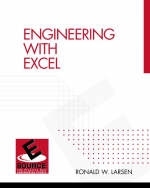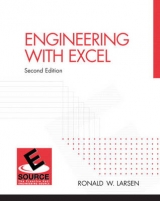
Engineering with Excel
Pearson (Verlag)
978-0-13-017696-7 (ISBN)
- Titel erscheint in neuer Auflage
- Artikel merken
For courses in Computer Methods.
An extensive text thoroughly covering the application of Excel to Engineering. This book is best for those who will spend a significant amount of time covering Excel during a semester or quarter, those who require that their students have a complete engineering reference to excel, or those who want to learn to apply excel to engineering problems on their own. This text is designed for all users from introductory to graduate students.
Ron Larsen is a Professor of Chemical Engineering at Montana State University, and received his Ph.D. from the Pennsylvania State University. He was initially attracted to engineering by the challenges the profession offers, but also appreciates that engineering is a serving profession. Some of the greatest challenges he has faced while teaching have involved non-traditional teaching methods, including evening courses for practicing engineers and teaching through an interpreter at the Mongolian National University. These experiences have provided tremendous opportunities to learn new ways to communicate technical material. Dr. Larsen views modern software as one of the new tools that will radically alter the way engineers work, and his book Introduction to MathCAD was written to help young engineers prepare to meet the challenges of an ever-changing workplace.
1. Introduction to Excel.
Introduction. Starting Excel. A Little Windows. Spreadsheet Basics. Printing the Spreadsheet. Saving, Opening Workbooks, and Exiting.
2. Graphing with Excel.
Introduction, Getting Ready to Graph: Importing Text Files. Creating an XY Scatter Plot. Editing an Existing Graph. Creating Graphs with Multiple Curves. Printing the Graph. Types of Graph.
3. Excel Functions.
Introduction to Excel Functions. Excel's Built-in Functions. Using the CONVERT ( ) Function to Convert Units. Simple Math Functions. Computing Sums. Trigonometric Functions. Inverse Trigonometric Functions. Advanced Math Functions. Conditional Formatting. Error Function. Bessel Functions. Working with Complex Numbers. Working with Binary, Octal, and Hexadecimal Values. Miscellaneous Functions.
4. Matrix Operations in Excel.
Matrix Manipulations: Vectors, Matrices, and Arrays. How Excel Handles Matrix Math. Basic Matrix Operations. Solving Systems of Linear Equations.
5. Linear Regression in Excel
Introduction. Linear Regression Using Excel Functions. Linear Regression Using Excel's Trend Line Capability. Other Two-Coefficient Linear Regression Models. Polynomial Regression. Linear Regression Using Excel's Regression Analysis Package.
6. Iterative Solutions Using Excel.
Introduction. Iterative Solutions. Introduction to Excel's Solver. Optimization Using the Solver. Nonlinear Regression. Testing the Regression Result.
7. Using Macros in Excel.
Introduction. Macros and Viruses. Recorded Macros. Programmed Macros (VBA)
8. Programming in Excel with VBA.
Introduction. Visual Basic for Applications (VBA) Overview. Forms and Modules. Working with Forms. Using the Form from the Spreadsheet.
9. Sharing Excel Information with Other Programs.
Introduction to Sharing Excel Information with Other Programs. Using Copy and Paste to Move Information. Embedded and Linked Objects. External Data Sources.
10. Time Value of Money with Excel.
Time, Money, and Cash Flows. Interest Rates and Compounding. Moving Amounts through Time. Economic Alternatives: Making Decisions.
11. Financial Calculations with Excel.
Introduction. Internal Rate of Return and Net Present Value. Depreciation of Assets.
12. Excel's Statistics Functions.
Overview. Populations and Samples. Standard Deviations and Variances. Errors, Deviations, and Distributions. Confidence Intervals.
13. Numerical Differentiation Using Excel.
Finite Differences. Filtering Data. Curve-Fitting and Differentiation.
14. Numerical Integration Using Excel.
Integrating for Area under a Curve. Integrating for Area Between Two Curves. Numerical Integration Methods. Using Regression Equations for Integration.
15. Numerical Integration Techniques for Differential Equations Using Excel.
Euler's Method. Fourth-Order Runge-Kutta Method. Integrating Two Simultaneous ODEs Using the Runge-Kutta Method. Implicit Methods.
Index.
| Erscheint lt. Verlag | 28.11.2001 |
|---|---|
| Sprache | englisch |
| Maße | 202 x 253 mm |
| Gewicht | 906 g |
| Themenwelt | Informatik ► Office Programme ► Excel |
| Technik | |
| ISBN-10 | 0-13-017696-6 / 0130176966 |
| ISBN-13 | 978-0-13-017696-7 / 9780130176967 |
| Zustand | Neuware |
| Informationen gemäß Produktsicherheitsverordnung (GPSR) | |
| Haben Sie eine Frage zum Produkt? |
aus dem Bereich



